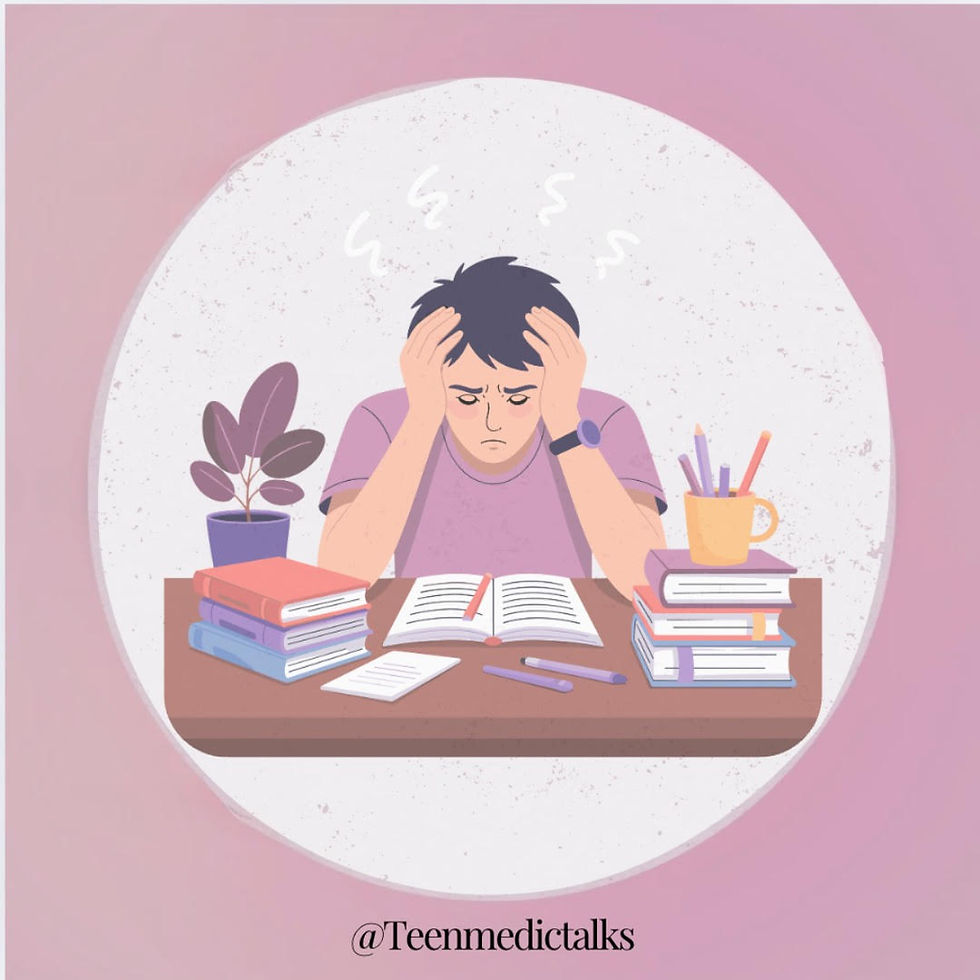Type 1 Diabetes and How it May Affect Teenagers
- Amy Lian
- Oct 13
- 4 min read
Type one diabetes is a chronic autoimmune disease that prevents your pancreas from making insulin by destroying the insulin-producing cells. Insulin is a hormone produced by the pancreas that plays a crucial role in regulating blood sugar levels. Without insulin, the body cannot properly regulate blood sugar levels, eventually leading to serious health problems with serious consequences (Cleveland Clinic, 2025b). In the United States, an estimated 352,000 children and adolescents younger than the age of 20, had diagnosed diabetes. This includes 304,000 with type one diabetes in 2021, and the numbers have most likely increased by then (CDC, n.d.-b). Understanding how this condition affects teens is crucial as it not only impacts their physical health, but also has psychological and social effects.
Type one diabetes develops when the immune system attacks the beta cells in the pancreas. Beta cells are specialized endocrine cells that are located in the pancreas that produce and secrete the hormone insulin. This autoimmune reaction often begins in individuals who have a genetic predisposition, sometimes even triggered by environmental factors such as viral infections. When the immune system detects these changes, it identifies insulin-proficient cells as foreign and destroys them (Sciencedirect, n.d.-a). This condition significantly differs from type two diabetes. In type one diabetes, your body is unable to make insulin at all since the insulin-producing cells have been attacked and destroyed by your immune system. Type two diabetes on the other hand, is when your body isn’t making enough insulin or what makes it work properly, which is why it’s not known as an autoimmune disorder (Gary-JayBourley, n.d.). Common symptoms of type one diabetes include but are not limited to, having to use the restroom frequently, excessive dehydration and drinking a lot, losing weight, and feeling tired all the time (Patterson, C. Ed. 2021).
There are many physical effects on daily life for teenagers who have type one diabetes. The symptoms that come along with it, such as profound fatigue and a lack of energy for daily activities and school can make it hard to focus or participate. Frequent urination, thirst, and irritability are also common, which can have a toll in the individual’s day-to-day activities. Managing the condition requires ongoing effort, such as monitoring blood sugar multiple times a day, close monitoring of carbohydrate intake, etc., can be very demanding and requires significant amounts of effort. Long-term complications can include eye problems (e.g. cataracts or glaucoma), heart diseases, or even diabetic ketoacidosis, which is a serious health condition that can happen as a result of diabetes and requires immediate emergency care (Cleveland Clinic, 2025b; Mayo Foundation for Medical Education and Research, n.d.). All of these physical challenges can make living with type one diabetes exhausting and demanding for teenagers.
Beyond the physical symptoms that type one diabetes may affect teenagers, there are also social and mental health impacts of this condition. The daily burden of disease management can increase the risk of depression and anxiety, or even eating problems. Constant monitoring and restrictions can often make teens feel “different” from peers, causing emotional distress (van Duinkerken, E., Snoek, F. J., & de Wit, M., 2020). Teens may even experience burnout, causing them to become disengaged in self-care, develop unhealthy eating habits, and more. Socially, the condition can interfere with normal teenage experiences such as hanging out with friends and participating in activities, because they must always consider their insulin level and diet. This can lead to feelings of isolation and the fear of being judged by peers.
While living with type one diabetes can be very challenging, proper treatment and support can make a tremendous change and difference. Treatments for type one diabetes include taking insulin, counting carbohydrates, fats, and proteins, monitoring blood sugar often, and exercising frequently. The goal is to keep the blood sugar level as close to normal as possible to delay or prevent complications (Mayo Foundation for Medical Education and Research, 2024). Emotional and social support are just as equally important. Teens can benefit from joining social support peer groups or community programs where they meet others who are facing similar experiences and challenges. These spaces can foster understanding and build confidence, reducing the risk of isolation. Families can also play a huge role from educating siblings to helping create a supportive environment where teens feel comfortable enough in discussing their struggles. Even offering positive feedback for their efforts can go a long way, boosting their motivation and self-esteem.
Type one diabetes can affect teenagers in all sorts of ways, ranging from physical, mental, and social impacts. Its daily demands can be overwhelming, but with the right medical care, emotional support, and community awareness, teens can manage their condition successfully. Encouraging open conversations, fostering support groups, and promoting awareness can help empower young people with type one diabetes to live a fulfilling, healthy life.
Works Cited:
Ashraff, S., Siddiqui, M. A., & Carline, T. E. (2013, May). The psychosocial impact of diabetes in adolescents: A Review. Oman medical journal. https://pmc.ncbi.nlm.nih.gov/articles/PMC3679608/
Mayo Foundation for Medical Education and Research. (2024, March 27). Type 1 diabetes. Mayo Clinic. https://www.mayoclinic.org/diseases-conditions/type-1-diabetes/symptoms-causes/syc-20353011
Centers for Disease Control and Prevention. (n.d.-b). National Diabetes Statistics Report. Centers for Disease Control and Prevention. https://www.cdc.gov/diabetes/php/data-research/index.html#:~:text=29.7%20million%20people%20of%20all,a%20year%20of%20their%20diagnosis.
Decoding the immune dance: Unraveling the interplay between beta cells and type 1 diabetes - sciencedirect. (n.d.-a). https://www.sciencedirect.com/science/article/pii/S2212877824001297
Gary-JayBourley. (n.d.). Differences between type 1 and type 2 diabetes. Diabetes UK. https://www.diabetes.org.uk/diabetes-the-basics/differences-between-type-1-and-type-2-diabetes#:~:text=Both%20are%20serious%20conditions%20that,of%20other%20types%20of%20diabetes.
Patterson, C. (Ed.). (2021, September). What is type 1 diabetes? (for teens) | nemours kidshealth. KidsHealth. https://kidshealth.org/en/teens/type1.html#:~:text=People%20who%20have%20type%201,show%20up%20later%20in%20life.
Type 1 diabetes: Causes, symptoms, Complications & Treatment. Cleveland Clinic. (2025b, September 24). https://my.clevelandclinic.org/health/diseases/21500-type-1-diabetes#:~:text=People%20with%20Type%201%20diabetes%20need%20to%20monitor%20their%20blood,sugar%20in%20the%20following%20ways:
van Duinkerken, E., Snoek, F. J., & de Wit, M. (2020, April). The cognitive and psychological effects of living with type 1 diabetes: A narrative review. Diabetic medicine : a journal of the British Diabetic Association. https://pmc.ncbi.nlm.nih.gov/articles/PMC7154747/#:~:text=Young%20people%20with%20type%201,neuroinflammation%2071%20has%20been%20postulated. https://www.breakthrought1d.org/t1d-resources/relationships/supporting-teenagers-with-t1d/
Mayo Foundation for Medical Education and Research. (n.d.). Diabetic ketoacidosis. Mayo Clinic. https://www.mayoclinic.org/diseases-conditions/diabetic-ketoacidosis/symptoms-causes/syc-20371551









Comments